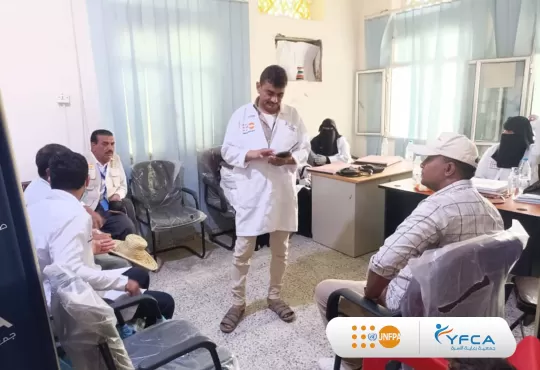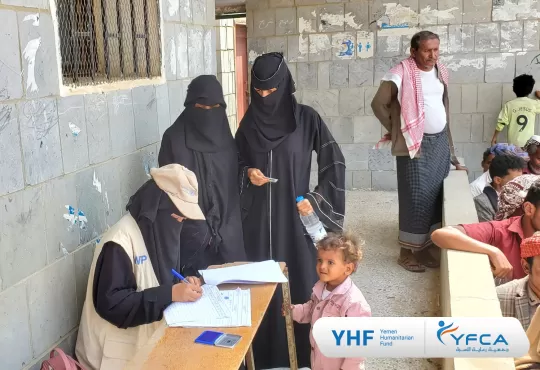-
IMPLEMENTATION OF PROGRAM COMPONENTS
Component 1: Reproductive Health
1.1 Commodity Security of Family Planning Methods
The use offamily planning (FP) is considered a key factor for reaching the desired fertility rates and lowering the population growth rate. FP contributed to the prevention of unintended pregnancies as well as it is an important factor in improving the health of mothers and children and the economy of families.
As studies show that there is an increased demand on FP in Yemen,and given the limited resources allocated by government to procurement and distribution of FP methods at a wide scale, YFCA continued its leading role in accordance in distributing FP methods and providing family planning services.
The 2003 PAPFAM survey found that the contraceptive prevalence of modern method among Yemeni women was 13.4% (27% in urban and 9.2% in rural areas). The 2006 MICS found a prevalence of contraception of 27.7% (modern 19%) among married women (12.7% in rural and 33.7% in urban areas; 21.1% in rural and 42.3% in urban for any method). The unmet need for family planning, however, concerned about a quarter of married women (24%). A recent KAP study[1] on 1400 men and women in reproductive age reported a contraceptive prevalence of 37.8% (modern 28.4%). To this trend, the modern contraception prevalence will reach 41% in 2015 and Yemen will have to wait more than 20 years to reach 60%, a proportion compatible with a very low unmet need.[2]
YFCA has provided family planning methods and services during 2011-2012 in many Yemeni governorates through health centers, mobile clinics, Safe Motherhood Specialized Hospital in addition to a network of tens qualified midwives. YFCA has reached more than 313,978 commodities distributed over 13 governorates out of 21 governorates in Yemen through our health centers and mobile clinics.
A significant increase took place in the demand for family planning services and contraceptives. For example, the number of beneficiaries and visitors to our health center in Sana’a increased from 31,569 to 38,865.
Table (2) shows FP method distributed during 2011-2012 per governorate through health centers, NGOs and Midwives:
|
No. |
Governorate |
Microgynon |
Microlet |
IUD |
Condom |
Implants |
Depoprovera |
|
1 |
Sana'a City |
39167 |
36200 |
9161 |
410 |
638 |
2434 |
|
2 |
Sana'a Gov. |
37488 |
22810 |
1675 |
115 |
0 |
1215 |
|
3 |
Hadramout |
9000 |
13080 |
1850 |
230 |
130 |
475 |
|
4 |
Dhamar |
61600 |
39620 |
3100 |
190 |
0 |
1075 |
|
5 |
Sa'da |
24720 |
12720 |
600 |
55 |
0 |
0 |
|
6 |
Aden |
15080 |
12800 |
1000 |
203 |
0 |
2300 |
|
7 |
Ibb |
20880 |
14240 |
1800 |
335 |
0 |
1800 |
|
8 |
Hodaiddah |
1440 |
4560 |
500 |
30 |
0 |
375 |
|
9 |
Hajjah |
5850 |
11610 |
1025 |
0 |
0 |
650 |
|
10 |
LAHJ |
1440 |
2400 |
0 |
0 |
0 |
500 |
|
11 |
Gawf |
80400 |
25320 |
2100 |
35 |
0 |
1600 |
|
12 |
Ma'reb |
24000 |
9000 |
0 |
24 |
0 |
0 |
|
13 |
Abyan |
7920 |
3600 |
1000 |
20 |
0 |
400 |
|
14 |
Taiz |
720 |
90 |
100 |
3 |
0 |
0 |
|
15 |
Raymah |
7200 |
3600 |
1050 |
0 |
0 |
0 |
|
16 |
Total |
336905 |
211650 |
24961 |
1650 |
768 |
12824 |
[1]Marie Stopes International.2010, KAP study on contraception and HIV/AIDS 2010. Health Management Research & Training Institute, Sana'a.
[2] National Strategy for Reproductive Health, Ministry of Public Health and Population, 2011
Figure ( 2) shows the trends in distribution of FP methods per governorate.


